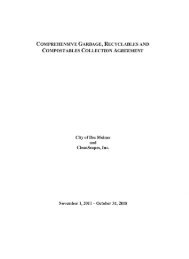CITY OF DES MOINES SHORELINE MASTER PROGRAM
CITY OF DES MOINES SHORELINE MASTER PROGRAM
CITY OF DES MOINES SHORELINE MASTER PROGRAM
You also want an ePaper? Increase the reach of your titles
YUMPU automatically turns print PDFs into web optimized ePapers that Google loves.
Des Moines Shoreline Master Program<br />
5.1.3 Designation Criteria<br />
High-intensity environments are shoreline areas that currently support high-intensity uses related<br />
to commerce, transportation or navigation; or are suitable and planned for high-intensity wateroriented<br />
uses.<br />
5.1.4 Boundary Description<br />
1. The limits of shoreline jurisdiction between South 222nd Street and Massey Creek as shown<br />
on Figure 5-1, representing the official Des Moines SMP map. This area includes the Des<br />
Moines Marina and other water-dependent development.<br />
2. The limits of shoreline jurisdiction between South 282nd Street and South 283rd Street as<br />
shown on Figure 5-1, representing the official Des Moines SMP map. This area includes the<br />
Redondo Boat Launch, the Highline Community College Marine Science and Technology<br />
Center, and other water-oriented development.<br />
5.2 Urban Conservancy Environment<br />
5.2.1 Purpose<br />
The purpose of the “urban conservancy” environment is to protect and restore ecological<br />
functions in urban and developed settings, while allowing a variety of compatible uses. This<br />
environment applies to publicly owned areas in the shoreline jurisdiction, including Des Moines<br />
Beach Park and Saltwater State Park. These public lands may offer conservation and/or<br />
restoration opportunities, such as conserving and enhancing nearshore and stream channel<br />
habitat. An additional purpose is to provide appropriate public access and recreational uses.<br />
5.2.2 Management Policies<br />
1. The primary allowed uses should preserve the natural character of the area or promote<br />
preservation of open space, flood plain or sensitive lands either directly or over the long<br />
term.<br />
2. Water-dependent uses should be given highest priority. Water-oriented uses should be given<br />
priority over non-water-oriented uses.<br />
3. Create development standards for setbacks, buffers, shoreline stabilization, vegetation<br />
conservation and enhancement, critical areas protection, and water quality to assure no net<br />
loss of shoreline ecological functions, and contribute to the restoration of ecological<br />
functions over time in areas where ecological degradation has occurred.<br />
4. Activities and uses that would substantially degrade or permanently deplete the physical or<br />
biological resources of the area should be prohibited.<br />
5. Uses that result in restoration of ecological functions should be allowed if the use is<br />
otherwise compatible with the environment and the setting. New development should be<br />
restricted to that which is compatible with the natural and biological limitations of the land<br />
and water and will not require extensive alteration of the land/water interface.<br />
Department of Ecology approval effective November 1, 2010<br />
56 Adopted by City of Des Moines Ordinance No. 1502



